MOTOCROSS ACTION TEST IMPRESSION: WHAT IT’S LIKE TO RACE THE 2013 KTM 250SX

2013 KTM 250SX: This is a 218-pound, two-stroke powered, 50-horsepower razor blade.
MXA has a very simple test procedure ? we race. Yes, we sit through tech briefings, do studio photography, shoot action photos, get our ears blasted in the dyno room and spend long weekdays trying different settings, but in the end ? we race. With each race we switch test riders, rotating through Novice, Intermediate, Pro, Vet, old, young, fat, slim, smart and stupid test riders. We have fast test riders and we have slow test riders…and until slow people are banned from buying bikes we will pay a little more attention to their needs than Pro riders. An MXA test is the distilled info from a wide range of talents, ages and peccadillos.
In order to make all of this work, we have to schedule the bikes that each test rider will ride…because MXA typically tests six different bikes during any single month (and we want every test rider to have as much time on the bike as he wants or needs). We also travel to Cahuilla Creek, RaceTown, Comp Edge, Elsinore, Glen Helen and Piru to try different dirt, terrain and layouts. The MXA guys often split the work load, but eventually they come back together at REM Glen Helen to resolve any setup or test issues. We consider the REM track a “dirt dyno” because it is where MXA test riders can push the bikes on very familiar dirt (of course, we dyno, weigh and sound test every bike also). This is MXA‘s process, and has been since 1973. It is how we do it. Yes, it is very different from how other magazines test bikes, but it works for us because motocross bikes are primarily made for motocross racers.
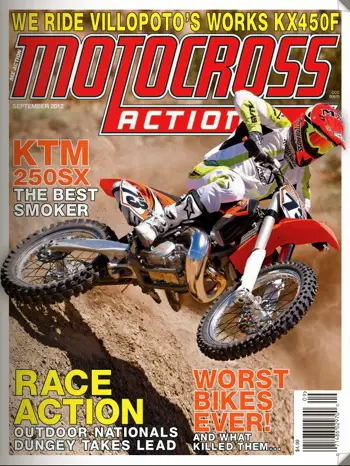
To find out more about the 2013 KTM 250SX, a lot more, get the September issue of MXA.
And, we haven?t given up on two-strokes. We believe in them and have a complete test fleet of 2013 smokers ? and several test riders whose main purpose in life is to race two-strokes on a weekly basis to try every combination possible. In that vein, MXA thought that you’d like a quick impression of the 2013 KTM 250SX. If you want a more detailed and comprehensive test of the KTM 250SX, pick up the September issue of MXA…the one with the KTM 250X on the cover. In there you will find everything from suspension settings to jetting specs to problem areas. What we are showing you here isn’t a test in the true MXA sense of the word, but a quick and limited view at what the bike is like.
2013 KTM RACE IMPRESSION

Thanks to a change to “American spec” suspension settings, the 2013 KTM 250SX is better suited to American tracks and riders.
What did KTM change from 2012 to 2013 on the 250SX? Ten things:
(1) Swingarm. The swingarm has been reinforced and enlarged at the axle ends to accept a larger 25mm axle (last year’s axle was 20mm).
(2) Plastic. The most noticeable cosmetic changes are the I-beam front fender, orange rear fender and gun metal gray frame.
(3) Gas cap. The new thread-on gas cap is a big improvement over the smaller, quarter-turn, locking cap.
(4) Triple clamps. The 2013 clamps are lighter and the bottom pinch bolts have been moved from fore/aft to left/right orientation.

KTM mounts the 250SX silencer on floating nylon brackets. Very trick.
(5) Handlebars. Last year’s Renthal 672 bars have been replaced with 12mm taller Renthal 827 bars.
(6) Wheels. The most obvious changes are the black anodized spokes and larger wheel spacers, brake carrier and axle block made to accommodate the new 25mm rear axle.
(7) Radiators. The radiators are stronger.
(8) Reed block. For 2013 the KTM 250SX get the 5mm thicker Moto Tassinari VForce4 reed block.
(9) Clutch. The 2013 250SX will get the Belleville washer, single-spring, Damped Diaphragm Steel clutch from the 450SXF.
(10) Suspension. For 2013 KTM has upgraded the 250SX to American specs. Which means a shorter shock (4mm) and stiffer fork springs (from 0.44 to 0.46 kg/mm).
HOW FAST IS IT?
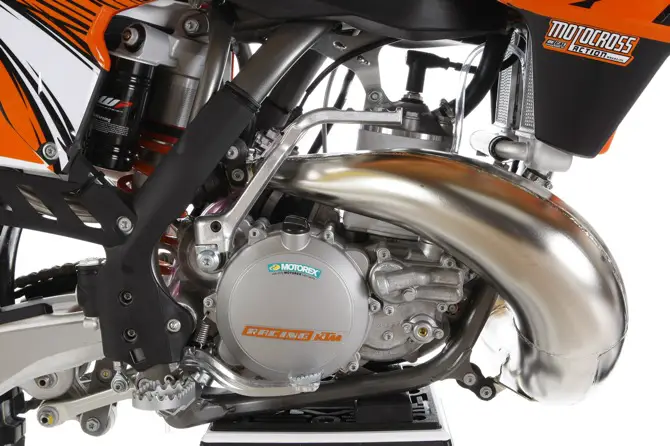
Already the fastest 250cc two-stroke it can easily be made faster yet.
It makes 50 horsepower (that is the most of any 250cc two-stroke), but that isn’t what the KTM 250SX is all about. By two-stroke standards it is easy to ride with a broad spread of power and a solid delivery. However, by four-stroke standards it is snappy, abrupt and very quick. For an MXA test rider jumping off of a four-stroke it takes about 30 minutes of riding to adjust to the light weight, quick power, and lack of decompression braking. For MXA test riders jumping off of a Yamaha YZ250, it was a much simpler switch, they just have to adjust to the fact that the KTM 250SX makes over four horsepower more than the blue bike.
Of course MXA wanted more out of the KTM 250SX and we got that with an aftermarket pipe. We tested both FMF and Pro Circuit pipes and felt that both added more power to the 250SX’s powerband. With aftermarket exhaust pipes the KTM gained power down low and power on top ? although it didn’t necessarily gain much in the way of peak horsepower.
For clutch abusers KTM plans to offer a stiffer Belleville washer through their Power Parts catalog. We think this will be a big plus for hardcore two-stroke racers and KTM 450SXF owners. The stiffer clutch spring, which has been tested by Ryan Dungey on his 450SXF, will allow two-stroke riders to hammer the clutch, while 450SXF riders don’t have to worry about the heavy flywheels grinding the plates down.
WHAT DID MXA CHANGE ON THE 250SX?
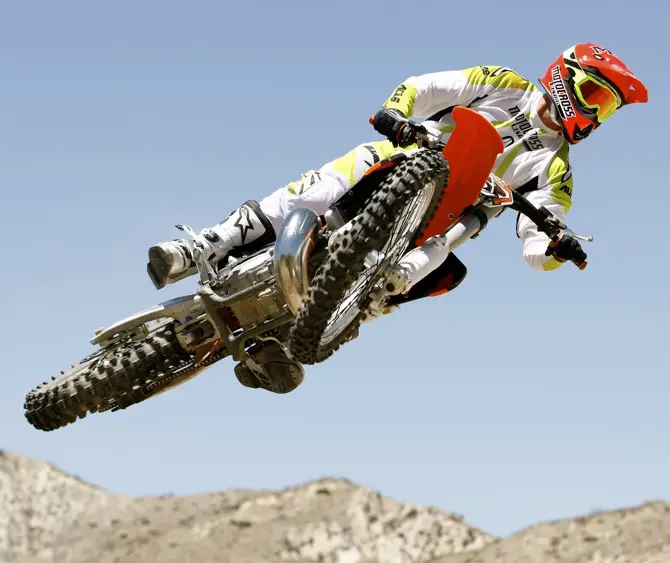
You haven’t lived until you’ve flown through the air on a 218-pound two-stroke. You can whip a two-stroke, even if you’ve never gotten your thumper slightly akilter.
We tried a wide range of options.
(1) Jetting: Obviously we don’t live in your town, run the same brand of gas or ride like you do, so understand that our jetting specs are ours. We present them to you as a example of what worked for us. We stuck with the stock 158 main, but went to a leaner 40 pilot (stock is 42). We also ran the option N1EH needle instead of the stock N1EI. In cold weather, really cold, we might go back to the stock settingS and even consider a 160 main.
(2) Carb swap. We switched the stock 36mm Keihin PWK for a modified 39mm carb from Dick’s Racing (www.dicksracing.com). Dick’s Intelajet carb mod is amazing.
(3) Forks. If you plan on sending your forks out to be revalved, you can skip this section, but we lowered the oil height from 380cc to 370cc to get the midstroke to smooth out. Faster or heavier riders had to fiddle in 5cc increments to get what they wanted?with the biggest complaint coming from fast guys who could bottom if they went too low.
(4) Shock. Faster and heavier rider swapped out the stock 5.4 kg/mm shock spring for a 5.7, but most riders will be capable of living with the 5.4. We run a Pro Circuit shock linkage because it lowers the rear of the 250SX and stiffens up the initial part of the shock’s stroke. Lowering the rear is a big deal to shorter riders and improves the handling for riders of all heights.
(5) Seat. It is too soft. Our option is to switch to an Acerbis X-Seat. A word of warning ? as soft as the stock KTM seat is the X-Seat is hard, but we preferred its rounded shape (and would rather have a seat that is too firm than one that is too soft).
(6) Tires. We can live with the MX51 rear, but not the MX51 front. It is constantly vague. That means that you could race with it, but you would never feel comfortable because it pushes a little bit all the time. Most MXA test riders switch to a Dunlop MX31 front tire or Bridgestone 403/404 tires.
THE COMPLETE PACKAGE
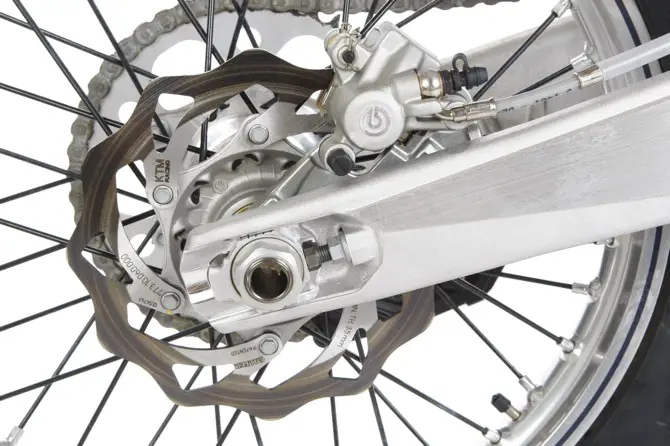
The big rear axle is more than just a larger nut and bolt. It increases lateral rigidity to improve tracking in the corners.
We love…
The brakes. Awesome, powerful, controllable and lightyears above what the Japanese-made brands offer.
The handling. If you take the time to carefully adjust the fork tube height you can get the KTM 250SX to do whatever you want it to do…without having to ask it to do it.
The feel. Not everyone is cut out to race a two-stroke…even the best 250cc two-stroke made. A two-stroke is why motocross became popular in the 1970s. It is a thrill to ride compared to a four-stroke. It is light (218 pounds compared to 240 pounds for the typical 450 four-stroke). It is agile (it can turn anywhere). It wheelies (it has a light, loose and agile feel that is so different from a four-stroke that it is almost a different sport). It is fun (you can’t believe how quick things are happening…it is a E-Ticket ride).
The cost. A 2013 KTM 250SX costs close to $2000 less than a 2013 KTM 450SXF. That two grand could finance your racing season. We don’t think that two-stroke are more reliable than four-strokes. They do require maintenance and new parts on a regular basis ? it’s just that those parts are cheaper and you can do the work yourself.
The exclusivity. We know that the 250SX isn’t for everyone. How do we know. Not every MXA test rider has gulped down the two-stroke Kool-Aid.
This is not the full test from the magazine, just an impression. For more info, get the September 2012 issue of MXA.
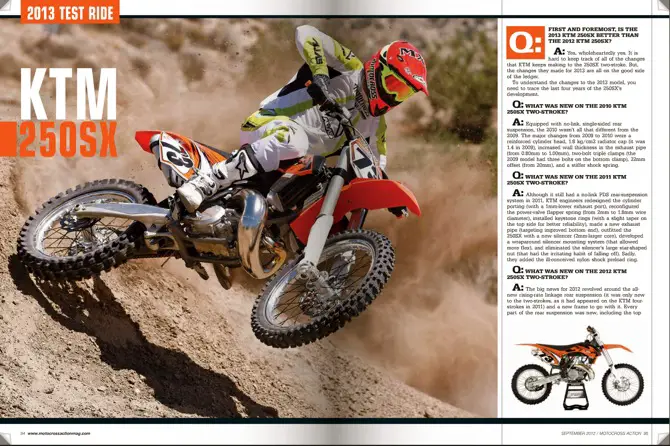
There is nothing like wheelying out of the turn with the front end high and a smile on your face.




Comments are closed.